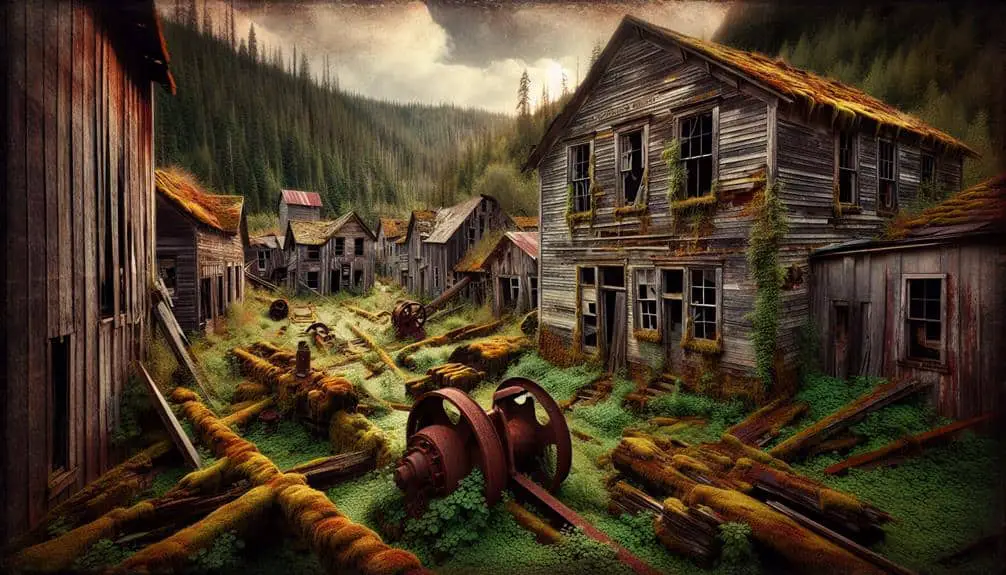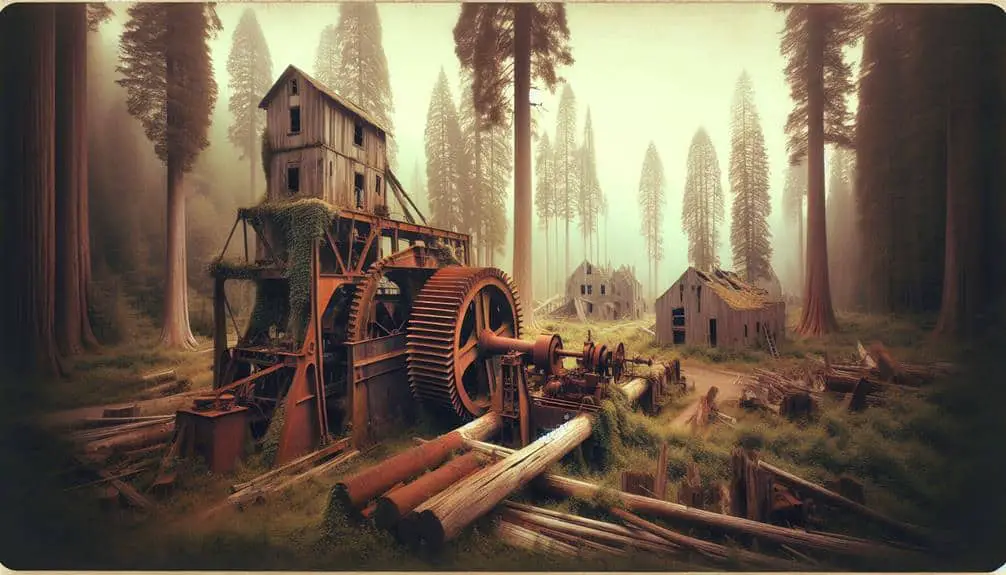Logging industry ghost towns exist due to economic shifts, technological advancements, and changing migration patterns. Economic downturns reduce job opportunities, while automation leads to fewer jobs. As younger generations move to urban areas, logging settlements face population decline. Environmental regulations also impact industry practices, sometimes causing job losses. Neglect of cultural heritage adds to the desolation. These towns are a complex blend of lost livelihoods and abandoned stories, impacted by larger forces.
Key Points
- Economic downturn reduces job opportunities in logging towns.
- Technological automation leads to fewer job opportunities in the industry.
- Migration patterns shift as younger generations seek urban employment.
- Neglect of cultural heritage in abandoned towns erases traditions and stories.
- Population decline strains local businesses and infrastructure in logging settlements.
Economic Shifts Impacting Logging Towns
As economic forces continue to evolve, the logging industry faces significant challenges that have a direct impact on the towns built around it. Economic downturns can trigger a domino effect within these communities, leading to a decline in job opportunities and a strain on local businesses. The resilience of these towns is tested as they grapple with the repercussions of a struggling logging industry.
Urbanization plays an important role in the rural depopulation witnessed in logging towns. As more people migrate to urban areas in search of better prospects, these once-thriving communities are left grappling with shrinking populations. The exodus of residents not only impacts the social fabric but also strains the local economy, resulting in a cycle of decline.
Navigating through these economic shifts requires innovative solutions and a collective effort from both the logging industry and the communities it sustains. Finding a balance between adapting to changing economic landscapes and preserving the essence of these logging towns is essential for their survival in the face of evolving challenges.
Environmental Regulations and Logging Communities
The impact of environmental regulations on logging communities becomes increasingly pronounced as sustainability concerns drive shifts in industry practices and community dynamics. Government oversight plays a pivotal role in ensuring that logging activities adhere to environmental standards, which can sometimes lead to challenges for logging communities. While these regulations are essential for protecting the environment, they can also result in job losses or decreased productivity in logging towns that heavily rely on the industry for economic stability.
However, with proper community support and adaptation, logging towns can navigate these challenges more effectively. By fostering a collaborative relationship between industry stakeholders, local residents, and regulatory bodies, logging communities can work towards sustainable practices that benefit both the environment and the economy. This cooperation can lead to innovative solutions that mitigate the negative impact of regulations on logging towns while promoting long-term environmental stewardship. Ultimately, finding a balance between government oversight, community support, and sustainable logging practices is key to ensuring the resilience and prosperity of logging communities in the face of evolving environmental regulations.
Technological Advances and Abandoned Logging Towns
Technological advancements have played a significant role in the transformation of abandoned logging towns. The impact of automation in the logging industry has been profound, leading to increased efficiency but also contributing to rural abandonment. As technology evolved, manual labor once performed by a large workforce in logging towns was gradually replaced by automated processes. This shift not only reduced the need for human labor but also altered the economic landscape of these communities.
The introduction of advanced machinery like feller-bunchers and automated sawmills revolutionized the logging industry, allowing companies to streamline operations with minimal human intervention. While this led to higher productivity levels, it also meant fewer job opportunities for residents in logging towns. As a result, many people were forced to leave their homes in search of employment elsewhere, leading to the decline and ultimate abandonment of these once-thriving settlements.
The intersection of automation impact and rural abandonment highlights the complex relationship between technological progress and the social fabric of logging communities.
Migration Patterns and Decline of Logging Settlements
Migration patterns of logging town residents reflect a ripple effect caused by the technological advancements in the industry, shedding light on the gradual decline of these once vibrant settlements. As logging practices evolved, requiring fewer manual laborers due to automation and mechanization, the demographic changes within these towns became evident.
Families who'd relied on logging for generations found themselves facing tough choices as job opportunities dwindled. Younger generations sought employment elsewhere, drawn to urban areas offering diverse work options and a more modern lifestyle. This shift in migration patterns led to a decline in the population of logging settlements, with many residents choosing to leave in search of better prospects.
The exodus of people from these towns not only impacted the workforce but also strained local businesses and community infrastructure. Understanding these migration patterns is vital in grasping the wider implications of the decline of logging settlements and the challenges faced by those who once called these places home.
Cultural Heritage Loss in Logging Ghost Towns
Amidst the eerie silence of abandoned streets and crumbling structures, one can discern the fading echoes of a rich cultural tapestry unraveling in logging ghost towns. The neglect of these once-bustling communities not only safeguards future generations of their historical roots but also erases the stories and traditions that once thrived within these wooden walls. Heritage preservation becomes pivotal in safeguarding the essence of these towns, preventing their complete disappearance into obscurity.
The cultural heritage loss in logging ghost towns signifies a broader trend of forgetting our past in the pursuit of progress. Without a concerted effort towards conserving the unique narratives embedded in these abandoned spaces, we risk losing valuable insights into our shared history. Community revitalization initiatives that embrace the historical significance of these towns could breathe new life into forgotten streets and rejuvenate a sense of belonging among residents.
As we confront the challenge of cultural heritage loss in logging ghost towns, it's essential to view these spaces not just as remnants of the past but as opportunities for renewal and connection. Through heritage preservation and community revitalization efforts, we can safeguard that the legacy of these ghost towns endures, enriching our present and inspiring our future.
Frequently Asked Questions
How Did the Logging Industry Impact the Overall Economy of the Region Where Ghost Towns Exist?
The logging industry heavily influenced the region's economy, leading to booms and busts. Economic impact was significant, affecting jobs, infrastructure, and local businesses. Migration patterns shifted with logging activity, shaping the community's development.
What Specific Environmental Regulations Have Had the Biggest Impact on Logging Communities and Their Decline?
Investigating the impact of regulations on logging communities reveals a tangled web of economic repercussions. As rules tighten, jobs vanish, and towns wither. Environmental protection clashes with industry survival, leaving ghost towns as the silent witnesses.
How Have Technological Advances in Logging Equipment Contributed to the Abandonment of Logging Towns?
Technological advances in logging equipment have had a significant impact on the industry and led to job displacement in many logging towns. The rise of automation has streamlined operations but also contributed to abandonment.
What Are the Main Reasons Behind the Migration Patterns That Have Led to the Decline of Logging Settlements?
Migration patterns in logging towns have shifted due to economic impact. People leave for better opportunities, abandoning settlements. This exodus leads to the decline of logging towns and the creation of ghost towns.
How Has the Loss of Cultural Heritage in Logging Ghost Towns Affected the Surrounding Communities?
You might imagine the disappearance of cultural heritage in logging ghost towns as a seismic rupture, fracturing community cohesion. This loss ripples through the fabric of society, triggering profound socioeconomic repercussions that endure.



